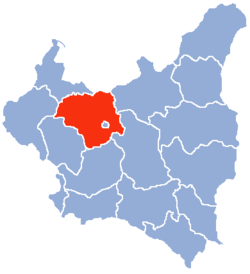Warsaw Voivodeship (1919-1939)
| Warsaw Voivodeship Województwo warszawskie |
|||||
| Voivodeship of Poland | |||||
|
|||||
| Warsaw Voivodeship (red) on the map of Second Polish Republic | |||||
| Capital | Warsaw | ||||
| Government | Voivodeship | ||||
| Voivodes | |||||
| • | 1919-1927 | Władysław Sołtan | |||
| • | 1938-1939 | Jerzy Paciorkowski | |||
| Historical era | Interwar period | ||||
| • | Established | 14 August 1919 | |||
| • | Territorial changes | 1 April 1938 | |||
| • | Annexed by Germany | September 1939 | |||
| Area | |||||
| • | 1921 | 29,342 km2(11,329 sq mi) | |||
| • | 1939 | 31,656 km2(12,222 sq mi) | |||
| Population | |||||
| • | 1921 | 2,112,798 | |||
| Density | 72 /km2 (186.5 /sq mi) | ||||
| • | 1931 | 2,460,900 | |||
| Political subdivisions | 22 powiats, 53 cities | ||||
Warsaw Voivodeship (Polish: województwo warszawskie) was a voivodeship of Poland in the years 1919–1939. Its capital and biggest city was Warsaw.
In the years 1919–1939, Warsaw Voivodeship covered north-central part of Poland, bordering East Prussia to the north, Pomorze Voivodeship and Łódź Voivodeship to the west, Kielce Voivodeship to the south and both Lublin Voivodeship and Białystok Voivodeship to the east. Its area, after April 1, 1938, was 31 656 km² (see: Territorial changes of Polish Voivodeships on April 1, 1938). The landscape was flat. Forests covered only 11.4% of the area, compared to the national average of 22.2%, as of January 1, 1937.
According to the 1931 Polish census, the population was 2 460 900. Poles made up 88.3% of population, Jews - 9.7% and Germans - 1.6%. The Jews and the Germans preferred to live in the cities and towns, especially in Warsaw itself. In Warsaw, in 1931, only 70.7% of population was Polish, with 28.3% Jews. In the whole Voivodeship, 21.8% of the population was illiterate as of 1931.
...
Wikipedia


